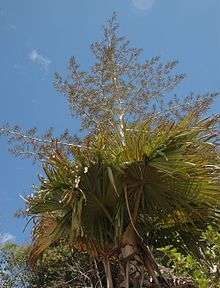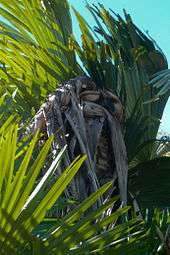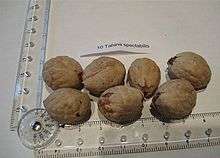Tahina spectabilis
Tahina spectabilis, the tahina palm, is a species of gigantic palm that is found only in the Analalava District of northwestern Madagascar. It can grow 18 m (59 ft) tall and has leaves over 5 m (16 ft) across. An individual tree was discovered when in flower in 2007; it was first described the following year as a result of photographs being sent to Kew Gardens in the United Kingdom for identification. The palm is thought to live for up to fifty years before producing an enormous inflorescence and subsequently dying. Fewer than one hundred individuals of the species are thought to exist and the International Union for Conservation of Nature has rated it as "critically endangered".
| Tahina spectabilis | |
|---|---|
 | |
| Scientific classification | |
| Kingdom: | Plantae |
| Clade: | Tracheophytes |
| Clade: | Angiosperms |
| Clade: | Monocots |
| Clade: | Commelinids |
| Order: | Arecales |
| Family: | Arecaceae |
| Subfamily: | Coryphoideae |
| Tribe: | Chuniophoeniceae |
| Genus: | Tahina J. Dransf. & Rakotoarinivo, 2008 |
| Species: | T. spectabilis |
| Binomial name | |
| Tahina spectabilis J. Dransf. & Rakotoarinivo, 2008 | |
Taxonomy
The species, which produces countless flowers and (after fruiting) dies, is sufficiently different from other known palms to justify the creation of the monotypic genus Tahina,[2] which is now included with three other genera in the tribe Chuniophoeniceae;[3] the other members being found in the Arabian peninsula, Thailand and China. Fewer than one hundred individuals of the species are thought to exist.[4][5]


Description
The palm is the largest of the 170 palm species native to Madagascar, having a trunk up to 18 m (59 ft) tall and leaves which are over 5 m (16 ft) in diameter.[6]
Tahina spectabilis normally appears much like other palms. However, when it flowers, which John Dransfield of the Royal Botanic Gardens, Kew estimates as occurring after every 30 to 50 years, the stem tip grows a large inflorescence that bursts into branches of hundreds of flowers. The drain on nutrients this display entails results in the death of the organism within several months.[7]
Discovery
The tahina palm was discovered by French cashew plantation manager Xavier Metz and his family, who were strolling through a remote northwestern region of Madagascar in 2007 when they came across a flowering individual and sent photos to the Kew Gardens for identification.[7]
Its name is derived from "Tahina", a Malagasy word meaning "to be protected" or "blessed", being the given name of Anne-Tahina Metz, the daughter of its discoverer, while "spectabilis" means spectacular in Latin.[6]
It was subsequently chosen as one of the top ten species discoveries of 2008 by the International Institute for Species Exploration.[8]
References
- Rakotoarinivo, M. & Dransfield, J. (2012). "Tahina spectabilis". IUCN Red List of Threatened Species. 2012: e.T195893A2430024. doi:10.2305/IUCN.UK.2012.RLTS.T195893A2430024.en.
- "Top 10 - 2009: A Palm that Flowers Itself to Death". Arizona State University. Archived from the original on May 25, 2009.
- Dransfield, John; Rakotoarinivo, Mijoro; Baker, William J.; Bayton, Ross P.; Fisher, Jack B.; Horn, James W.; Leroy, Bruno; Metz, Xavier (January 2008). "A new Coryphoid palm genus from Madagascar". Botanical Journal of the Linnean Society. 156 (1): 79–91. doi:10.1111/j.1095-8339.2007.00742.x.
- "Giant palm found on Madagascar flowers itself to death", AFP, 16 January 2008 (hosted by Yahoo! News) Archived 26 January 2008 at the Wayback Machine
- "Self-destructing palm tree discovered in Madagascar", "Associated Press", 16 January 2008 (hosted by CNN) Archived 19 January 2008 at the Wayback Machine
- "New Genus of Self-destructive Palm found in Madagascar". Royal Botanic Gardens, Kew. January 2008. Archived from the original on January 19, 2009. Retrieved November 22, 2014.
- Eccleston, Paul (17 January 2008). "Self destructing palm tree found in Madagascar". The Daily Telegraph. Archived from the original on 8 October 2014. Retrieved 26 June 2013.
- Arizona State University (May 23, 2009). "Pea-sized Seahorse, Bacteria That Life In Hairspray, Caffeine-free Coffee Among Top 10 New Species Of 2008". ScienceDaily. Retrieved November 22, 2014.
External links

